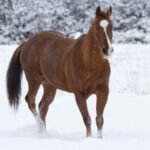Viking stallions, known for their strength, beauty, and spirited nature, can sometimes present unique training challenges for even the most experienced handlers. These magnificent horses, descended from Nordic stock brought to various regions by Viking settlers, possess a blend of power and independence that makes them both prized companions and occasionally difficult partners. When a Viking stallion decides not to cooperate, it creates a situation that requires patience, understanding, and proper techniques to resolve. This article explores the various scenarios that might occur when your Viking stallion becomes uncooperative, and provides practical guidance for addressing these challenges while maintaining a positive relationship with your equine companion.
Understanding the Viking Stallion Temperament

Viking stallions possess a unique temperament that stems from their historical breeding as both war horses and working animals in harsh Nordic conditions. These horses typically display a combination of intelligence, independence, and strong will that can manifest as stubbornness when they feel uncertain or challenged. Their natural herd instincts, where stallions lead and protect their groups, can translate into dominance testing with human handlers. Understanding that this behavior isn’t malicious but rather an expression of their natural instincts is crucial for developing appropriate responses. Rather than viewing their occasional refusal to cooperate as defiance, consider it communication that requires proper interpretation and addressing underlying causes.
Common Signs of Non-Cooperation in Stallions

Recognizing the warning signs of a Viking stallion’s reluctance to cooperate can help prevent escalation into more problematic behaviors. Initial indicators often include pinned ears, elevated head position, widened eyes showing the whites, or a swishing tail that signals irritation or anxiety. Physical resistance may manifest as planting feet firmly, backing up unexpectedly, or side-stepping away from the handler. More concerning behaviors might include rearing, striking with front hooves, or attempting to bite when approached or handled. Vocalizations such as snorting, squealing, or aggressive nickering can also indicate that your stallion is communicating discomfort or unwillingness to comply with requests. Early recognition of these signs allows for prompt intervention before the situation intensifies.
Physical Health Factors Affecting Cooperation

When a typically cooperative Viking stallion suddenly becomes resistant, the first consideration should always be potential physical health issues. Pain or discomfort from ill-fitting tack, dental problems, hoof issues, or musculoskeletal conditions can dramatically alter a horse’s willingness to work. Back pain in particular can make a stallion reluctant to accept a rider or perform certain movements that were previously routine. Hormonal fluctuations in stallions can also influence behavior, especially during breeding season when testosterone levels are elevated. A thorough veterinary examination is essential when behavior changes occur suddenly, as addressing underlying health concerns may completely resolve cooperation issues without requiring behavioral intervention.
Environmental Triggers for Uncooperative Behavior

Viking stallions, with their heightened awareness and sensitivity, often react strongly to environmental factors that might seem insignificant to handlers. New or unusual objects in their familiar environment, sudden loud noises, or the presence of unfamiliar horses (especially mares) can trigger defensive or distracted behavior. Weather conditions such as high winds or approaching storms can increase nervousness and reduce cooperation as their survival instincts become heightened. Confined or crowded spaces may trigger claustrophobia in some stallions, causing resistance to enter certain areas or facilites. Identifying these environmental triggers allows handlers to either modify the environment or gradually desensitize the stallion to these stimuli through controlled exposure and positive reinforcement.
Psychological Aspects of Stallion Resistance

The psychological dimensions of a Viking stallion’s resistance often stem from their inherent need for clear leadership and consistency. Confusion about expectations, inconsistent handling techniques, or mixed signals can create anxiety that manifests as uncooperative behavior. Past negative experiences or trauma can create lasting psychological barriers that trigger resistance when similar circumstances arise. Separation anxiety when removed from familiar companion horses can also lead to distracted, uncooperative behavior. Additionally, boredom and insufficient mental stimulation often result in resistance as an outlet for pent-up energy and intelligence. Creating predictable routines while incorporating appropriate mental challenges helps satisfy their psychological needs and improves willingness to cooperate.
Establishing Clear Leadership Without Dominance

Working successfully with a resistant Viking stallion requires establishing yourself as a confident leader without resorting to domination-based approaches. These intelligent horses respond best to handlers who demonstrate calm confidence and clear, consistent expectations rather than those who attempt to control through intimidation or force. Establishing leadership begins with controlling resources and movement—determining when feeding occurs, when and where movement happens, and maintaining personal space boundaries. Consistent handling routines with clear beginning and end signals help the stallion understand expectations. Using pressure and release techniques—applying light pressure that immediately releases when the desired response occurs—teaches the stallion that cooperation brings comfort. This balanced approach respects the stallion’s dignity while creating a relationship based on mutual respect rather than fear.
Ground Training Techniques for Resistant Stallions

Effective ground training forms the foundation for addressing cooperation issues in Viking stallions. The practice of groundwork establishes respect, communication, and boundaries before any mounted work begins. Techniques such as yielding to pressure at various points (shoulder, hindquarters, poll) teach the stallion to move away from gentle pressure rather than push against it. Lunging and liberty work improve focus on the handler while allowing natural expression of energy in a controlled environment. Desensitization exercises using progressive exposure to frightening objects or situations build confidence and trust in the handler’s leadership. For particularly resistant stallions, implementing techniques from natural horsemanship such as join-up can create breakthrough moments in establishing cooperation by leveraging the horse’s natural herd instincts in a controlled setting.
Riding Through Resistance Safely

When resistance occurs during riding, maintaining safety while working through the issues requires specific approaches and techniques. First and foremost, ensure you have established solid ground manners and respect before attempting to work through resistance under saddle. When resistance occurs during riding, maintain a calm, centered position rather than tensing or gripping with legs or hands, as tension transfers directly to the horse and escalates the situation. Use one-rein stops (bringing the horse’s head gently to one side) rather than pulling with both reins when a stallion becomes overly forward or threatening to rear. Redirecting energy rather than blocking it often proves more effective—asking for lateral movement or circles when a stallion balks or refuses to move forward. After successfully working through resistant behavior, always end on a positive note with something the horse can accomplish confidently, reinforcing that cooperation leads to comfort and praise.
Using Positive Reinforcement Effectively

Positive reinforcement training has shown remarkable results with resistant Viking stallions, leveraging their intelligence and sensitivity to create willing partners. This approach involves immediately rewarding desired behaviors with something the horse values—treats, scratches in favorite spots, verbal praise, or release of pressure. Clicker training, where a distinct clicking sound marks the exact moment of correct behavior followed by a reward, allows for precise communication and accelerated learning. Target training, teaching the horse to touch an object with his nose, provides a foundation for shaping more complex behaviors through successive approximations. Unlike traditional negative reinforcement (removing pressure when the horse complies), positive reinforcement creates enthusiasm for learning and strengthens the handler-horse bond through pleasant associations rather than avoidance of discomfort.
The Role of Professional Intervention

Certain situations with resistant Viking stallions warrant seeking professional assistance to ensure safety and achieve resolution. Professional trainers specializing in problem horses bring extensive experience, emotional detachment, and refined timing that can address issues more efficiently than owners who may have developed counterproductive patterns with their horses. Veterinary behaviorists can identify and address issues stemming from medical or psychological causes that might not be apparent to owners or traditional trainers. When considering professional help, look for trainers who use methods compatible with your ethics and the temperament of Viking horses—avoid those using extreme dominance or fear-based approaches. Participating in the training process rather than simply sending the horse away provides owners with the skills needed to maintain progress after professional intervention concludes.
Managing a Stallion in a Herd Environment

Viking stallions’ natural herd dynamics significantly influence their behavior and willingness to cooperate with humans in various contexts. In natural settings, stallions establish and defend territories, protect their mares, and maintain order through complex social interactions. These instincts don’t disappear in domestic environments and can affect how stallions respond to handling, especially when other horses are visible or within scent range. Establishing appropriate turnout routines that consider these instincts—such as using double fencing between stallions and mares or creating strategic turnout rotations—can reduce hormonal distractions. Training sessions conducted away from other horses initially helps establish focus before gradually introducing distractions. Understanding that certain times of year, particularly during breeding season (spring through early summer), may require adjusted handling and training expectations as natural hormonal drives intensify.
Nutrition and Exercise Impact on Behavior

The diet and exercise regimen of Viking stallions directly impacts their mental state and willingness to cooperate. High-energy grain concentrates without corresponding physical exercise can create excess energy that manifests as resistance, fidgeting, or explosive behavior during handling and riding. Irregular exercise schedules that alternate between periods of stall rest and intense work can create physical and mental stress that reduces cooperation. Certain feed additives and supplements can help regulate mood and energy levels—magnesium, B-vitamins, and omega-3 fatty acids have shown beneficial effects on equine behavior in some cases. Implementing a consistent exercise program with adequate turnout time—ideally 6+ hours daily—promotes physical and mental well-being while reducing stress-related resistance behaviors.
Long-Term Strategies for Building Partnership

Developing a true partnership with a Viking stallion extends beyond addressing immediate resistance to creating a foundation for lifelong cooperation and mutual respect. Consistent handling across all interactions—not just during formal training sessions—reinforces expectations and builds the stallion’s confidence in his human leaders. Incorporating variety through cross-training in different disciplines prevents mental stagnation and keeps intelligent stallions engaged and willing. Balancing structured work with recreational activities like trail riding allows the stallion to use his mind in different contexts while strengthening the bond with his handler. Celebrating small improvements rather than focusing solely on end goals maintains positive momentum and prevents frustration for both horse and handler. The most successful Viking stallion owners view resistance not as a problem to eliminate but as communication to interpret, creating dialogue rather than demanding compliance.
conclusion

Working with a resistant Viking stallion requires patience, knowledge, and strategic approaches tailored to these magnificent horses’ unique temperament and needs. By understanding the physical, environmental, and psychological factors that influence cooperation, handlers can address issues at their source rather than merely suppressing symptoms. Establishing leadership through clear communication, consistent expectations, and positive reinforcement creates willing partners rather than reluctant subjects. When challenges arise, viewing them as opportunities to deepen understanding and strengthen your relationship transforms potentially frustrating situations into valuable learning experiences. With the right approach, even the most initially resistant Viking stallion can become a trusted partner whose strength, intelligence, and spirit enhance rather than hinder your equestrian journey.







